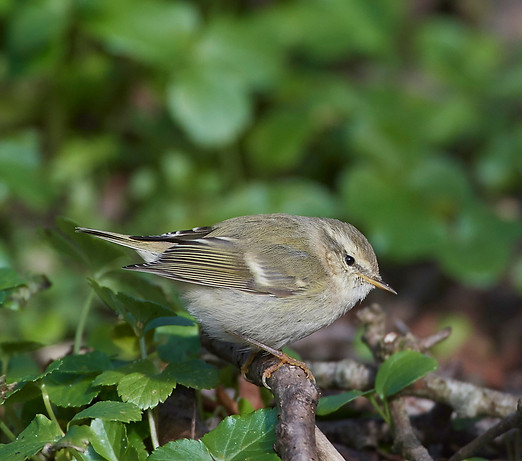
TG42 LOW-CARBON BIRDING
Hume's Warbler, Waxham Jan 6-19 2018 T.E. Allwood, A.J. Kane and P.J. Heath
(This was the 5th record of humei for TG42. Details of others can be seen in the pdf
On December 1st 2017, there was a Desert Wheatear at Eccles and while in the area, I found what was I was sure was an Arctic Redpoll but hadn’t manage to nail it as it was only seen in flight and perched very briefly. I spent much of Saturday and Sunday with Andy Kane and the redpoll, which was indeed a Coues's. However, that night there was a report of a Yellow-browed Warbler at Waxham (two miles away).
I called Andy and said “That’s odds on a Hume’s, surely?” In all the excitement, the “YBW” slipped our minds and as it wasn’t reported again, it was forgotten about. However a month later, a “YBW” was again reported at Waxham. This time, with nothing else on, I decided to be there the next morning. The bird was still present on arrival and was just about the only bird present too, making things slightly easier. It was very vocal but hard to see. Phil Heath had had the same idea and was also present on the south side of the gap and had also seen and heard the bird as it moved through the area. Andy and I spent a couple of hours pursuing the bird by voice and eventually managed to get some decent views although the bird was flighty and hard to observe. Over the next two weeks, a large number of people saw the bird and lots of excellent photos were obtained, some of which are attached below the description. I spent hours watching this bird often at incredibly close range. A real treat to have just down the road.
Description:
A small wing-barred phylloscopus, reminiscent at first glance of a Yellow-browed Warbler. However, the frequently given call was completely different, being the typical chu-wee type call of a Hume’s Warbler. I spent an inordinate amount of time watching the bird over those two weeks and 99% of the calls given were chu-wee calls. Rarely an uninflected note was given.
The plumage was duller and greyer than a typical Yellow-browed Warbler and notably the median covert bar was much less prominent and lacked the dark bar below it at the base of the secondaries. The wing bars were perhaps a little paler, whiter and less yellow/cream toned than a typical YBW. The upperparts were a little greyer and duller than a YBW and the underparts were similarly duller, lacking the contrast of a whiter-bellied YBW. The head pattern also appeared, duller, greyer and fuzzier than a YBW, lacking the cleanness and sharp contrasts of that species. This sometimes lent it a more plain-faced appearance, slightly like a Bonelli’s Warbler, with the eye looking a little more prominent. There was a slightly paler median crown area. The legs were a dark, dull pink in good bright light - on the brighter side of most Hume’s I’ve seen, especially when the sun shone through them - but they still lacked the brightness of a typical YBW. The tertial edges were similarly less contrasting and the bill was dull-looking in most field views but a paler base to the lower mandible could be made out in close views.
Some of the fantastic photos obtained are shown below. I can't remember who took them though, but thanks very much



